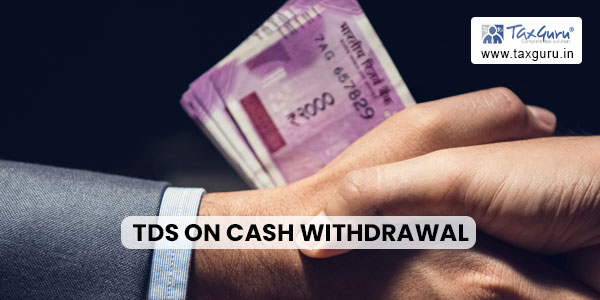“Discover the ins and outs of Section 194N – TDS on Cash Withdrawals. Uncover the threshold limits, applicability to individuals and entities, TDS rates, and recent amendments. Learn through illustrative examples for comprehensive insights. Stay informed and compliant with tax regulations.”
Section 194N is a provision in the Income Tax Act that deals with the deduction of tax from cash withdrawals. It was introduced to discourage large cash transactions and promote digital payments. The main idea behind this provision is to make people use electronic modes of payment instead of relying heavily on cash.
Under Section 194N, if you withdraw a large amount of cash from your bank account, the bank will deduct a certain percentage of tax from that cash before giving it to you
Section 194N mandates the deduction of TDS on cash withdrawals exceeding certain thresholds from specified entities. We will explore the provisions of this section and provide illustrative examples to help you understand its implications better.
1. Threshold Limits: Section 194N introduces TDS provisions on cash withdrawals to discourage the use of large cash transactions and promote digital transactions. The following threshold limits determine when TDS becomes applicable:

- Cash withdrawals exceeding Rs. 1 crore in aggregate from one or more accounts held with a banking company or cooperative bank.
- Cash withdrawals exceeding Rs. 20 lakh in aggregate from one or more accounts held with a banking company by a person who is liable to file an income tax return.
2. Applicability: Section 194N applies to various entities involved in cash withdrawals, including individuals, HUFs (Hindu Undivided Families), trusts, companies, partnerships, and more. It is important to note that the TDS deduction under this section is made by the banking company or cooperative bank on behalf of the account holder.
3. TDS Rate: The TDS rate for cash withdrawals exceeding the specified threshold limits is 2%. This means that if you withdraw cash above the thresholds mentioned earlier, the bank will deduct 2% of the amount as TDS before you receive the cash.
4. The rate of TDS under Section 194N is 2%. However, the rate of TDS is 5% if the following conditions are met:
- The aggregate amount of cash payments made during the financial year exceeds ₹ 1 crore.
- The PAN of the recipient is not available.
- The recipient has not filed income tax returns for any of the previous three assessment years.
- The recipient’s account is not linked with Aadhaar.
The 5% rate of TDS is applicable from April 1, 2023. This amendment was made in the Finance Act, 2021, with the aim of curbing the generation of black money.
Here is an example of how the 5% rate of TDS under Section 194N would work:
- Mr. A withdraws ₹ 1.2 crore in cash from his bank account during the financial year.
- Mr. A’s PAN is not available.
- Mr. A has not filed income tax returns for any of the previous three assessment years.
- Mr. A’s account is not linked with Aadhaar.
In this case, the bank would be required to deduct TDS at the rate of 5% on the entire amount of cash withdrawal, i.e. ₹ 60,000.
5. Illustrative Examples: Let’s go through a couple of examples to understand how TDS under Section 194N works:
Example 1: Rahul, an individual, withdraws a total of Rs. 1.2 crore in cash from his savings account with a bank in a financial year. As the cash withdrawals exceed Rs. 1 crore, TDS will be applicable. The bank will deduct 2% of the excess amount (Rs. 20 lakh) as TDS and provide Rahul with the remaining Rs. 1 crore in cash.
Example 2: ABC Corporation, a company, withdraws a total of Rs. 18 lakh in cash from its current account with a bank in a financial year. As the cash withdrawals do not exceed the threshold of Rs. 20 lakh, TDS will not be applicable. The bank will provide ABC Corporation with the full amount of Rs. 18 lakh in cash without any tax deduction.
Example 3: Sara, an individual who is required to file an income tax return, withdraws a total of Rs. 25 lakh in cash from her bank account during the financial year. As the cash withdrawals exceed Rs. 20 lakh, TDS will be applicable. The bank will deduct 2% of the excess amount (Rs. 5 lakh) as TDS and provide Sara with the remaining Rs. 20 lakh in cash.
Example 4: XYZ Trust, a registered trust, withdraws a total of Rs. 1.5 crore in cash from its savings account with a cooperative bank. As the cash withdrawals exceed Rs. 1 crore, TDS will be applicable. The cooperative bank will deduct 2% of the excess amount (Rs. 50 lakh) as TDS and provide XYZ Trust with the remaining Rs. 1 crore in cash.
Remember, the TDS deducted is reflected in the Form 26AS, which serves as a consolidated statement of tax credits. The TDS can be claimed as a tax credit while filing the income tax return.
Conclusion: Tax Deduction at Source (TDS) on cash withdrawals under Section 194N aims to curb large cash transactions and encourage digital payments. By understanding the threshold limits, applicability, TDS rate, and reviewing illustrative examples, you can better grasp the implications of Section 194N and ensure compliance with the income tax regulations.





